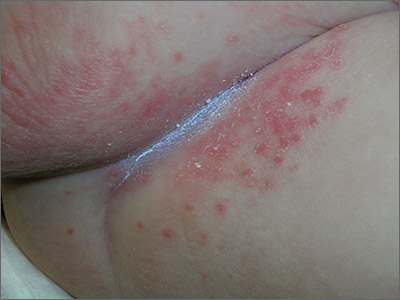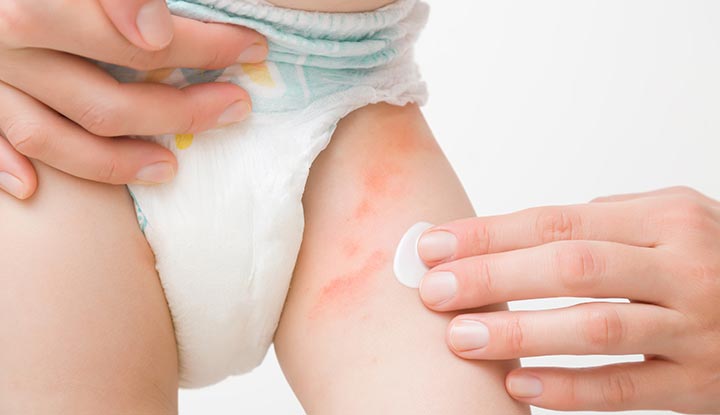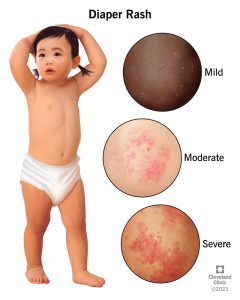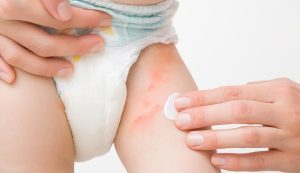Thrush diaper rash is a yeast infection that occurs in a baby’s diaper area. It causes redness, irritation, and a raised, bumpy rash.
If left untreated, it can spread to other areas of the body. Thrush diaper rash is a common condition that affects many babies. It is caused by an overgrowth of yeast in the diaper area, usually due to moisture and lack of air circulation.
This can occur when a baby wears a wet or dirty diaper for extended periods of time. The warm and moist environment provides an ideal breeding ground for yeast to thrive. If your baby has a thrush diaper rash, it is important to take prompt action to treat the condition and prevent further discomfort. We will explore the causes, symptoms, and treatment options for thrush diaper rash, as well as provide some tips for prevention.
Understanding Thrush Diaper Rash
Thrush diaper rash is a common yeast infection that affects babies. It appears as red, raised patches in the diaper area and can be accompanied by white patches in the mouth. Understanding the symptoms and seeking prompt treatment is essential to providing relief for the baby.
Understanding Thrush Diaper Rash diaper rash is a common condition that affects many infants and young children. It is characterized by a bright red rash that is typically found in the diaper area. This type of diaper rash is caused by an overgrowth of yeast known as Candida albicans. In this section, we will explore the causes and symptoms of thrush diaper rash, providing you with a comprehensive understanding of this discomforting condition.
Causes of Thrush Diaper Rash diaper rash occurs when the natural balance of yeast and bacteria in a baby’s body is disrupted. There are several factors that can contribute to this imbalance, including: 1. Antibiotics: The use of antibiotics, either by the mother during breastfeeding or directly administered to the baby, can disrupt the natural balance of yeast and bacteria in the body. 2. Moisture: The warm and moist environment created by a wet diaper provides the perfect breeding ground for yeast to thrive. 3. Friction: Constant rubbing and chafing of the diaper against the baby’s sensitive skin can cause irritation and lead to diaper rash. 4. Weakened immune system: Babies with weakened immune systems are more susceptible to developing diaper rash. Therefore, it is crucial to identify the underlying causes in order to effectively treat and prevent thrush diaper rash.
Symptoms of Rash
Symptoms of Thrush Diaper Rash Recognizing the symptoms of thrush diaper rash is important for prompt treatment. Here are some common signs to look out for: 1. Bright red rash: The affected area will appear red and inflamed, extending beyond the diaper area. 2. Raised borders: The rash may have distinct borders that are raised and take on a lumpy or bumpy texture. 3. Pustules or blisters: Small pustules or blisters may be present on the rash, indicating infection. 4. Itching and discomfort: The baby may exhibit signs of discomfort, such as scratching or fussiness. 5. Persistence: Regular diaper rash creams may not alleviate the symptoms of thrush diaper rash, as it is caused by yeast rather than bacteria.
By understanding the causes and symptoms of thrush diaper rash, you can take proactive measures to prevent and treat this uncomfortable condition. In the next section, we will explore effective strategies for managing and treating thrush diaper rash. Stay tuned for helpful tips and techniques to provide relief for your little one.
:max_bytes(150000):strip_icc()/recognizing-and-treating-a-yeast-diaper-rash-284385_V22-b70e081800c743f0bef2a2bac5d11112.jpg)
Diagnosing Thrush Diaper Rash
Diagnosing diaper rash is crucial for effective and timely treatment. Recognizing the symptoms and seeking a medical evaluation play a key role in the diagnosis process. Let’s take a closer look at how to identify and diagnose diaper rash in infants.
Recognizing Thrush Diaper Rash
Diaper rash often presents as a bright red rash with distinct borders. This rash may contain small, raised bumps and be accompanied by white patches in the mouth. Babies may exhibit signs of discomfort, such as increased fussiness during diaper changes. Parents should be vigilant for these symptoms when considering the possibility of thrush diaper rash.
Medical Evaluation And Diagnosis
Upon suspecting thrush diaper rash, an evaluation by a healthcare professional is essential. The healthcare provider will conduct a thorough examination to assess the extent of the rash and inquire about the baby’s feeding habits. In some cases, a sample from the affected area may be collected for further analysis to confirm the presence of yeast. This comprehensive medical evaluation aids in accurately diagnosing diaper rash and determining the most appropriate treatment plan.
Treating Thrush Diaper Rash
Are you dealing with thrush diaper rash and finding it difficult to treat? Worry no more because this blog post will provide you with the best methods for treating this uncomfortable condition. diaper rash, caused by a yeast infection, can be stubborn to eliminate. However, with the right treatments, both medical and natural, you can effectively relieve your baby’s discomfort and restore their delicate skin.
Medical Treatments
When it comes to medical treatments for thrush diaper rash, your pediatrician may recommend:
- Antifungal cream or ointment to directly target the yeast causing the rash.
- Oral antifungal medication for severe cases, which helps combat the infection from the inside out.
- Probiotics to restore the balance of good bacteria and yeast in your baby’s body.
Home Remedies And Natural Treatment Options
If you prefer natural remedies, consider these options:
- Gentle Cleansing: Regularly change diapers and cleanse the affected area with a mild, natural soap to keep the area clean and dry.
- Yogurt: Applying plain, unsweetened yogurt to the rash may help restore the balance of good bacteria.
- Coconut Oil: This natural antifungal can be applied to the rash to combat the yeast.
- Grapefruit Seed Extract: Dilute in water and apply to the rash to harness its natural anti-yeast properties.

Preventing Thrush Diaper Rash
Prevent thrush diaper rash with these simple tips: Keep the diaper area clean and dry, use a barrier cream, change diapers frequently, and avoid using scented products.
Maintaining Proper Hygiene
One of the key ways to prevent thrush diaper rash is to maintain proper hygiene for your baby. Keeping the diaper area clean and dry is crucial in avoiding the development of thrush. Here are some simple steps you can follow to ensure adequate hygiene:
- Change diapers frequently. Changing diapers as soon as they are soiled or wet helps to prevent prolonged exposure to moisture, which can create an ideal environment for thrush to thrive.
- Cleanse the diaper area gently. When cleaning your baby’s diaper area, use a mild soap and warm water. Avoid using harsh wipes with alcohol or fragrance that may irritate the skin. Pat the area dry using a soft towel or let it air dry before putting on a fresh diaper.
- Allow for diaper-free time. Giving your baby some diaper-free time during the day allows their skin to breathe and reduces the likelihood of diaper rash. Place a towel or waterproof mat underneath your baby to catch any accidents.
- Avoid tight diapers or clothing. Using diapers and clothing that are too tight can restrict air circulation and create a damp environment, promoting the growth of thrush. Opt for diapers and clothing that are breathable and provide a comfortable fit for your baby.
Dietary Adjustments For Prevention
To prevent thrush diaper rash, making some dietary adjustments for your baby can also be beneficial. Certain foods can contribute to an overgrowth of yeast, increasing the risk of thrush. Consider the following measures:
- Limit sugar intake. Yeast thrives on sugar, so reducing the amount of sugar in your baby’s diet can help prevent thrush. Avoid giving your baby sugary foods or drinks, such as candy, soda, and sweets.
- Encourage a balanced diet. Providing your baby with a nutritious, balanced diet strengthens their immune system and helps combat the growth of thrush. Incorporate plenty of fruits, vegetables, whole grains, and lean proteins into their meals.
- Consider probiotics. Probiotics are beneficial bacteria that can help maintain a healthy balance of yeast in the body. Consult with your pediatrician about incorporating probiotic supplements or foods, such as yogurt, into your baby’s diet.
Managing Thrush Diaper Rash In Babies, Tips For Parents And Caregivers
- Keep diaper area clean by gentle cleansing with warm water.
- Use a barrier cream to protect the skin from moisture.
- Frequent diaper changes are essential to prevent rashes.
- Avoid tight diapers that can cause friction and irritation.
When To Seek Medical Help
- Persistent rash despite home care measures.
- Spreading redness or swelling of the rash.
- Fever accompanied by the rash.
- White patches or sores in the diaper area.
Addressing Recurring Thrush Diaper Rash, Identifying Underlying Causes
Effective management of recurring diaper rash begins with identifying potential underlying causes.
- Frequent antibiotic use
- Sensitive skin
- Poor hygiene practices
Long-term Prevention Strategies
Implementing long-term prevention strategies is key to minimizing the recurrence of diaper rash.
- Frequent diaper changes
- Proper drying of the diaper area
- Use of breathable diapers
| Prevention Strategies | Description |
|---|---|
| Avoid tight diapers | Allows for air circulation to reduce moisture |
| Use of barrier cream | Creates a protective layer against moisture and irritants |
:max_bytes(150000):strip_icc()/what-are-the-symptoms-of-a-yeast-diaper-rash-284384_hl1-c1437d0be6194ce692af523feaf7fb2f.png)
What Does Thrush Diaper Rash Look Like?
Diaper rash appears as red, inflamed patches with distinct borders and satellite pustules.
How Do You Treat Thrush In The Diaper Area?
To treat thrush in the diaper area, use antifungal cream or ointment prescribed by a doctor. Keep the area clean and dry. Change diapers frequently. Let the skin breathe by using loose-fitting clothes.
How Do You Treat Thrush On A Baby’s Bottom?
To treat thrush on a baby’s bottom, clean the area gently and apply an antifungal cream or ointment. Change diapers frequently to keep the area dry and clean. Consult a healthcare professional for proper diagnosis and guidance.
How To Tell The Difference Between Yeast Diaper Rash And Yeast Infection?
Yeast diaper rash appears as red, inflamed skin, whereas a yeast infection presents as white, curd-like patches.
Conclusion
Treating and preventing diaper rash requires a combination of good hygiene practices, gentle and effective diapering techniques, and the use of antifungal creams. By keeping your baby’s bottom clean and dry, using breathable materials, and following the appropriate treatment plan, you can help alleviate discomfort and promote healing.
Remember, early intervention is key in managing thrush diaper rash and ensuring your little one stays comfortable and healthy.





